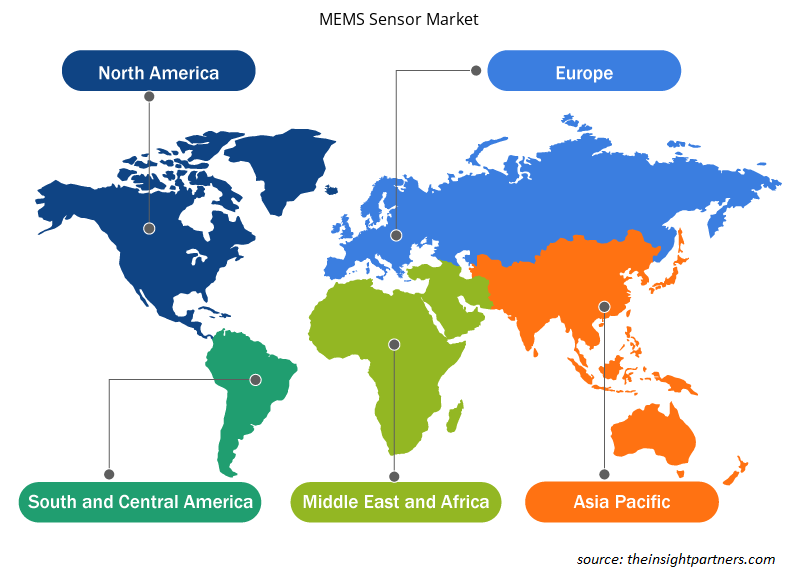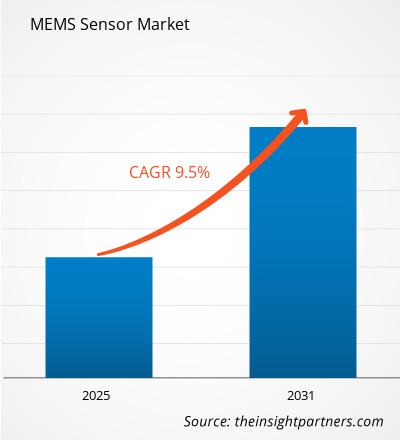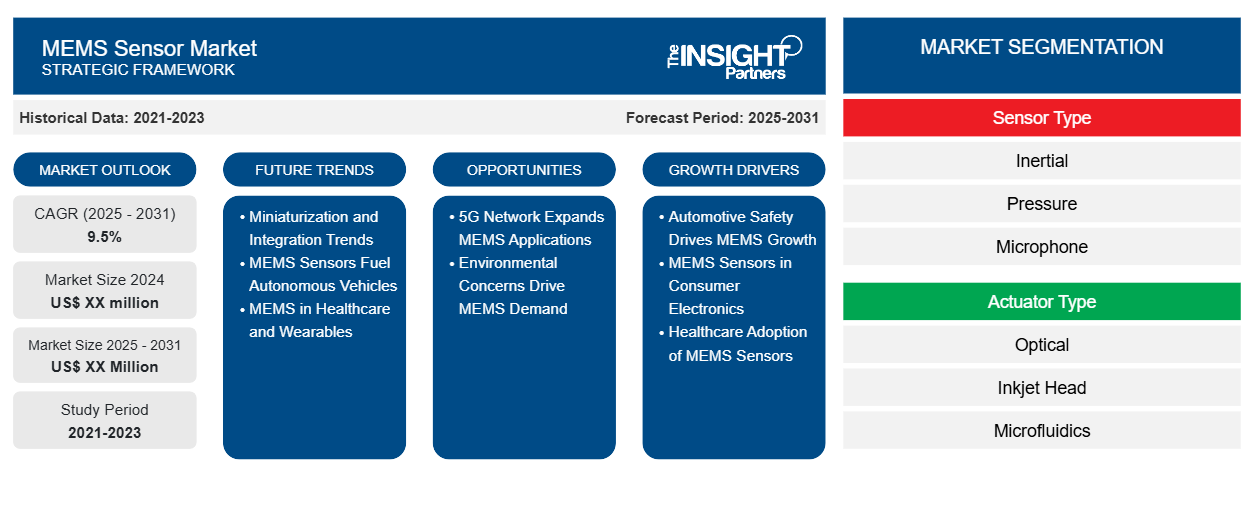من المتوقع أن يسجل سوق أجهزة استشعار MEMS معدل نمو سنوي مركب بنسبة 9.5٪ من عام 2024 إلى عام 2031، مع توسع حجم السوق من XX مليون دولار أمريكي في عام 2024 إلى XX مليون دولار أمريكي بحلول عام 2031.
يغطي تقرير سوق أجهزة الاستشعار MEMS التحليل حسب نوع المستشعر ونوع المحرك والعمودي والجغرافي. يغطي تقرير السوق أيضًا الاتجاهات الرئيسية والجهات الفاعلة في السوق.
غرض التقرير
يهدف تقرير سوق أجهزة الاستشعار MEMS الصادر عن The Insight Partners إلى وصف المشهد الحالي والنمو المستقبلي وأهم العوامل الدافعة والتحديات والفرص. وسيوفر هذا رؤى لمختلف أصحاب المصلحة في الأعمال التجارية، مثل:
- مزودي/مصنعي التكنولوجيا: لفهم ديناميكيات السوق المتطورة ومعرفة فرص النمو المحتملة، وتمكينهم من اتخاذ قرارات استراتيجية مستنيرة.
- المستثمرون: إجراء تحليل شامل للاتجاهات فيما يتعلق بمعدل نمو السوق، وتوقعات السوق المالية، والفرص المتاحة عبر سلسلة القيمة.
- الهيئات التنظيمية: لتنظيم السياسات ومراقبة الأنشطة في السوق بهدف تقليل الانتهاكات والحفاظ على ثقة المستثمرين ودعم سلامة السوق واستقرارها.
تجزئة سوق أجهزة استشعار MEMS
نوع المستشعر
- القصور الذاتي
- ضغط
- ميكروفون
- بيئي
- بصري
نوع المحرك
- بصري
- رأس نفث الحبر
- الميكروفلويديك
- تردد الراديو
رَأسِيّ
- السيارات
- الالكترونيات الاستهلاكية
- الدفاع
- صناعي
- الرعاية الصحية
- الاتصالات
- الفضاء الجوي
الجغرافيا
- أمريكا الشمالية
- أوروبا
- آسيا والمحيط الهادئ
- أمريكا الجنوبية والوسطى
- الشرق الأوسط وأفريقيا
قم بتخصيص هذا التقرير ليناسب متطلباتك
ستحصل على تخصيص لأي تقرير - مجانًا - بما في ذلك أجزاء من هذا التقرير، أو تحليل على مستوى الدولة، وحزمة بيانات Excel، بالإضافة إلى الاستفادة من العروض والخصومات الرائعة للشركات الناشئة والجامعات
- احصل على أهم اتجاهات السوق الرئيسية لهذا التقرير.ستتضمن هذه العينة المجانية تحليلاً للبيانات، بدءًا من اتجاهات السوق وحتى التقديرات والتوقعات.
محركات نمو سوق أجهزة الاستشعار MEMS
- إن القوة الدافعة وراء النمو في سوق أجهزة استشعار MEMS تأتي من زيادة تبني أنظمة السلامة في السيارات، بما في ذلك الوسائد الهوائية وأنظمة مساعدة السائق المتقدمة. وتشكل التطبيقات التي تتضمن مقاييس التسارع وأجهزة قياس الدوران MEMS خطوة مهمة نحو التحكم في الاستقرار واكتشاف الاصطدام، وتحسين سلامة المركبات. وأشارت تقارير السوق الأخرى إلى أن الطلب من صناعة السيارات سوف يهيمن بشكل كبير على اتجاهات السوق.
- أجهزة استشعار MEMS في الإلكترونيات الاستهلاكية: ظهرت أجهزة استشعار MEMS كمكون أساسي للهواتف الذكية والأجهزة القابلة للارتداء وأجهزة إنترنت الأشياء. وبالتالي، فإن الحاجة إلى أجهزة استشعار أكثر إحكاما ولكن عالية الأداء تعمل على تغذية حصة سوق أجهزة استشعار MEMS. وعلاوة على ذلك، بناءً على تحليل السوق، تشكل الإلكترونيات الاستهلاكية أكبر شريحة من حيث حصة السوق العالمية، حيث تساهم بنحو 35%.
- اعتماد أجهزة استشعار MEMS في مجال الرعاية الصحية: تعد الرعاية الصحية واحدة من الصناعات الرئيسية التي تتبنى أجهزة استشعار MEMS في التطبيقات، وخاصة مراقبة المرضى، والغرسات الطبية، والتشخيص. تقدم التكنولوجيا التي تدعم الإجراءات الطبية الأكثر دقة والأقل تدخلاً نظرة إيجابية لسوق أجهزة استشعار MEMS بسبب معدل اعتمادها المتزايد في مجال الرعاية الصحية، وفقًا لتحليل السوق العالمي.
الاتجاهات المستقبلية لسوق أجهزة الاستشعار MEMS
- اتجاهات التصغير والتكامل: تدفع اتجاهات التصغير والتكامل سوق أجهزة استشعار MEMS. حيث تعمل الشركات الكبيرة على تطوير أجهزة استشعار شديدة الصغر تدمج وظائف متعددة ضمن تصميم واحد؛ وبالتالي يتم تقليل المساحة مع زيادة الكفاءة. تسير ديناميكيات السوق وتحليل PEST جنبًا إلى جنب، مما يشير إلى زيادة الطلب في مجال السيارات والإلكترونيات الاستهلاكية مثل أكثر من 60% من الهواتف الذكية المزودة بجيروسكوبات وأجهزة قياس تسارع MEMS الحديثة. يفتح هذا الاتجاه إمكانيات مختلفة ويثير تحديات في تحليل SWOT، حيث تظهر القضايا الآن مع توسيع نطاق الإنتاج والأداء.
- أجهزة استشعار MEMS تعمل على تزويد المركبات ذاتية القيادة بالوقود: لذلك، تم تحفيز أجهزة استشعار MEMS من خلال التطوير في المركبات ذاتية القيادة. فهي توفر بيانات في الوقت الفعلي بشكل مستمر للملاحة واكتشاف الأشياء والسلامة. هذه هي الأساليب الحيوية في خط العمل، وبالتالي تحسنت دقة وموثوقية المستشعر. يمثل قطاع السيارات ما يقرب من 35٪ من الطلب على أجهزة استشعار MEMS في جميع أنحاء العالم. يشير النمو في هذا القطاع إلى فرص سوقية واسعة من خلال تحليل PEST؛ حيث يعمل الدعم التنظيمي والابتكارات التكنولوجية الجديدة على دفع مثل هذا الابتكار.
- الأنظمة الكهروميكانيكية الصغرى في الرعاية الصحية والأجهزة القابلة للارتداء: أحدثت أجهزة الاستشعار الكهروميكانيكية الصغرى ضجة كبيرة في قطاع الرعاية الصحية بفضل التشخيص والأجهزة القابلة للارتداء والمراقبة عن بعد. وتشير ديناميكيات السوق إلى أن أكثر من 25% من الأجهزة القابلة للارتداء تستخدم أجهزة استشعار الأنظمة الكهروميكانيكية الصغرى لتتبع العلامات الحيوية مثل معدل ضربات القلب وضغط الدم. ويستفيد اللاعبون الرئيسيون من التطورات في قطاع الرعاية الصحية في استراتيجياتهم السوقية. ويجد تحليل نقاط القوة والضعف والفرص والتهديدات أن هذه فرصة كبيرة، لكن التحديات التنظيمية ودقة البيانات المعرضة للخطأ تظل بالغة الأهمية.
فرص سوق أجهزة الاستشعار MEMS
- توسع شبكات الجيل الخامس تطبيقات MEMS: تفتح توسعات شبكات الجيل الخامس تطبيقات جديدة لأجهزة استشعار MEMS في سوق الاتصالات. وعلى المدى الطويل، بمجرد انتشار شبكات الجيل الخامس، ستحتاج 75% من جميع الأجهزة إلى دمج أجهزة استشعار MEMS لتحقيق الاتصال والأداء الأمثل. وتدل فرصة النمو على الابتكار في تصميم أجهزة الاستشعار وتطبيقها بالنسبة للمصنعين، وبالتالي الحفاظ على القدرة التنافسية في سوق الاتصالات المتغيرة باستمرار.
- المخاوف البيئية تدفع الطلب على أجهزة الاستشعار الكهروميكانيكية: إن المخاوف البيئية المتزايدة هي العامل الرئيسي الذي يدفع الطلب على أجهزة الاستشعار الكهروميكانيكية في مراقبة جودة الهواء ومكافحة التلوث. ومن المتوقع أن يصل حجم السوق العالمية لمراقبة البيئة إلى 25 مليار دولار بحلول عام 2025. ويمكن للمنظمات الاستفادة من هذا النمو من خلال إنشاء المزيد من أجهزة الاستشعار التي تقدم تحليلات في الوقت الفعلي لتحسين تحليلاتها التنافسية والمساعدة بشكل إيجابي في جهود الاستدامة عبر المناطق الجغرافية.
رؤى إقليمية حول سوق أجهزة الاستشعار MEMS
لقد قام المحللون في Insight Partners بشرح الاتجاهات والعوامل الإقليمية المؤثرة على سوق أجهزة الاستشعار MEMS طوال فترة التنبؤ بشكل شامل. يناقش هذا القسم أيضًا قطاعات سوق أجهزة الاستشعار MEMS والجغرافيا في جميع أنحاء أمريكا الشمالية وأوروبا ومنطقة آسيا والمحيط الهادئ والشرق الأوسط وأفريقيا وأمريكا الجنوبية والوسطى.

- احصل على البيانات الإقليمية المحددة لسوق أجهزة استشعار MEMS
نطاق تقرير سوق أجهزة الاستشعار MEMS
| سمة التقرير | تفاصيل |
|---|---|
| حجم السوق في عام 2024 | XX مليون دولار أمريكي |
| حجم السوق بحلول عام 2031 | XX مليون دولار أمريكي |
| معدل النمو السنوي المركب العالمي (2025 - 2031) | 9.5% |
| البيانات التاريخية | 2021-2023 |
| فترة التنبؤ | 2025-2031 |
| القطاعات المغطاة | حسب نوع المستشعر
|
| المناطق والدول المغطاة | أمريكا الشمالية
|
| قادة السوق وملفات تعريف الشركات الرئيسية |
|
كثافة اللاعبين في سوق أجهزة الاستشعار MEMS: فهم تأثيرها على ديناميكيات الأعمال
يشهد سوق أجهزة الاستشعار الكهروميكانيكية نموًا سريعًا، مدفوعًا بالطلب المتزايد من المستخدم النهائي بسبب عوامل مثل تفضيلات المستهلك المتطورة والتقدم التكنولوجي والوعي المتزايد بفوائد المنتج. ومع ارتفاع الطلب، تعمل الشركات على توسيع عروضها والابتكار لتلبية احتياجات المستهلكين والاستفادة من الاتجاهات الناشئة، مما يؤدي إلى زيادة نمو السوق.
تشير كثافة اللاعبين في السوق إلى توزيع الشركات أو المؤسسات العاملة في سوق أو صناعة معينة. وهي تشير إلى عدد المنافسين (اللاعبين في السوق) الموجودين في مساحة سوق معينة نسبة إلى حجمها أو قيمتها السوقية الإجمالية.
الشركات الرئيسية العاملة في سوق أجهزة الاستشعار MEMS هي:
- شركة هونيويل الدولية
- شركة NXP لأشباه الموصلات
- شركة باناسونيك
- شركة روبرت بوش المحدودة
- شركة سيليكس مايكروسيستم ايه بي
إخلاء المسؤولية : الشركات المذكورة أعلاه ليست مرتبة بأي ترتيب معين.

- احصل على نظرة عامة على أهم اللاعبين الرئيسيين في سوق أجهزة الاستشعار MEMS
نقاط البيع الرئيسية
- التغطية الشاملة: يغطي التقرير بشكل شامل تحليل المنتجات والخدمات والأنواع والمستخدمين النهائيين لسوق أجهزة استشعار MEMS، مما يوفر صورة شاملة.
- تحليل الخبراء: تم تجميع التقرير على أساس الفهم العميق لخبراء الصناعة والمحللين.
- معلومات محدثة: يضمن التقرير أهمية الأعمال التجارية بسبب تغطيته للمعلومات الحديثة واتجاهات البيانات.
- خيارات التخصيص: يمكن تخصيص هذا التقرير لتلبية متطلبات العملاء المحددة وبما يتناسب مع استراتيجيات العمل بشكل مناسب.
وبالتالي، يمكن أن يساعد تقرير البحث حول سوق أجهزة الاستشعار الكهروميكانيكية الصغرى في تمهيد الطريق لفك شفرة وفهم سيناريو الصناعة وآفاق النمو. ورغم وجود بعض المخاوف المشروعة، فإن الفوائد الإجمالية لهذا التقرير تميل إلى التفوق على العيوب.
- التحليل التاريخي (سنتان)، سنة الأساس، التوقعات (7 سنوات) مع معدل النمو السنوي المركب
- تحليل PEST و SWOT
- حجم السوق والقيمة / الحجم - عالمي، إقليمي، بلد
- الصناعة والمنافسة
- مجموعة بيانات إكسل
التقارير الحديثة
تقارير ذات صلة
شهادات العملاء
سبب الشراء
- اتخاذ قرارات مدروسة
- فهم ديناميكيات السوق
- تحليل المنافسة
- رؤى العملاء
- توقعات السوق
- تخفيف المخاطر
- التخطيط الاستراتيجي
- مبررات الاستثمار
- تحديد الأسواق الناشئة
- تحسين استراتيجيات التسويق
- تعزيز الكفاءة التشغيلية
- مواكبة التوجهات التنظيمية





















 احصل على عينة مجانية ل - سوق أجهزة استشعار MEMS
احصل على عينة مجانية ل - سوق أجهزة استشعار MEMS